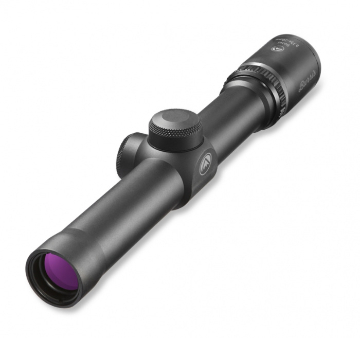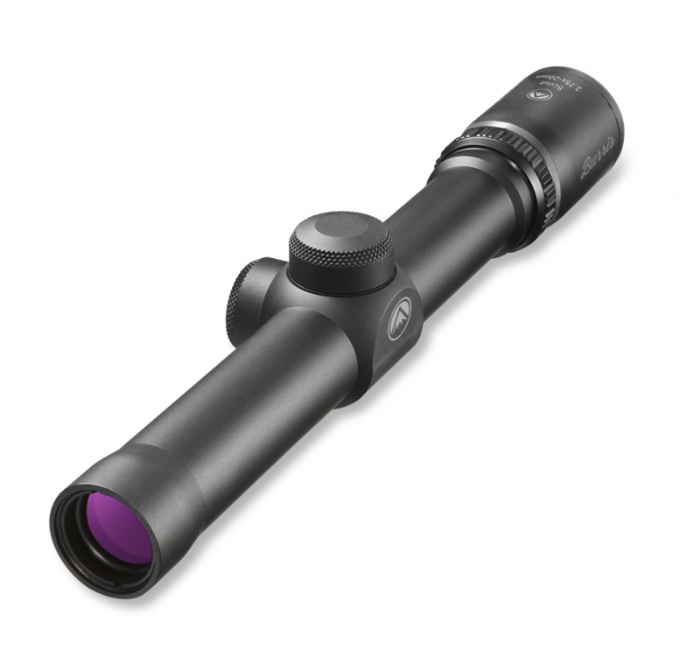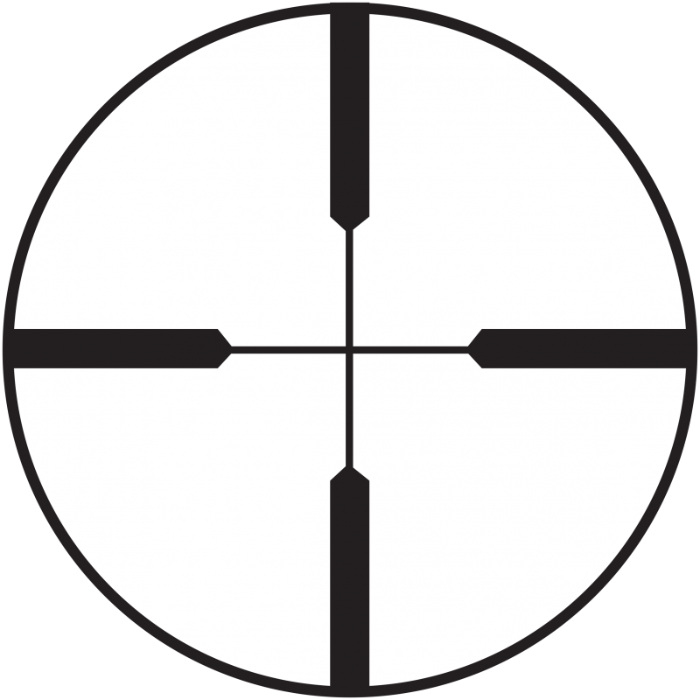While almost very similar to the Burris Scout 2-7x32 scope, the 2.75x20 model couldn’t be any more different.
How do they stack up against each other?
What is the fixed 2.75x scout scope good for?
Designed for scouting rifles, a scout scope is otherwise known as a forward mounting long eye relief scope.
If you need it to clear the action, use two eyes for shooting, or need a safe distance due to heavy recoil from large calibers, you need a scout scope.
This fixed model may be the cheaper option, but it’s as good as its variable power competitor.
Quick Overview...
What We Like: Scout scope
What We Don’t Like: Non-illuminated reticle
Best Uses: Big Game Hunting, Predator Hunting, Varmint Control, Scout Rifle, Extended Eye Relief, Close-Range, Light to Heavy Caliber Rifles
- Magnification: 2.75x
- Objective Diameter: 20mm
- Coatings: FMC
- FOV: 15 ft/100 yds
- Eye Relief: 8.5-14”
- Adjustments: ½ MOA
- Dimensions: 9.2”/7 oz

Our Verdict: If you want a robust, low-powered scout scope for your scout rifle, the fixed power 2.75x20 scope by Burris is an appropriate fit. No moving parts will interfere with quality, and with the thick crosshairs of the duplex reticle, it’s best suited to close-range 100-yard shooting. Keep things simple, keep reactions fast, and keep your eyes peeled. It’s what the Scout scope is made to do.
Who is the Burris Scout 2.75X20 Best Suited to?
The 2.75x20 scope is purpose-built for the scout rifle. It offers more magnification than a red dot sight but is also fixed for scope durability, less moving parts, and simplicity.
It can handle being mounted to your rifle of choice, can be used with two eyes open, and of course, it provides tons of eye relief to find the right mounting position and sweet spot in the eyebox for your shooting configuration and needs.
With the Heavy Plex reticle, everything is designed for sub-150 yard shots. It’s all about forward mounting, instant target acquisition, and a lightweight, accurate, and dependable system.
It’s also cheaper than the Burris Scout 2-7x32 version. So, if you’re into saving money, this is the top pick for you.
How Does the Burris Scout 2.75X20 Perform?

The Scout 2.75x20 scope is a titlist in its field. It provides the same physical benefits of any other scout scope but is incredibly lightweight. Mounting it is a non-issue since it offers 140 MOA total adjustment travel, and it takes standard 1” rings.
Build and glass quality is top-notch. Just because it’s a scout scope and small, it doesn’t mean that Burris didn’t outfit it with the same quality standards as their big scopes. It should perform well in low-light conditions given that it has good glass and a decent, usable exit pupil.
You can do away with complex reticles with a scout scope and employ Burris’ Heavy Plex Reticle with the 2.75x model. It’s a duplex made fat for fast target acquisition anywhere, anytime.
Perhaps there is a perception that it’s the red-headed stepchild of the Scout series, but it really can’t be compared. It’s a very different scope to the 2-7x32 model but offers the same quality that ensures performance. It’s also covered under the Forever Warranty and is significantly more affordable than its competitor as a scope under $300.
Features & Benefits

Scout Scope
The 2.75x20 is a scout scope all the way. It may be limited with no variable zoom power, but it does its job for close-range engagements and makes easy and efficient use of the Heavy Duplex reticle.
With eye relief of 8.5-14”, there is plenty there to acquire the long eye relief benefits you need. It also has a field of view of 15 feet at 100 yards which is within the industry standard for such low power from a scout scope. But when you have the ability to keep both eyes open, you essentially have an unlimited field of view.
Excellent Quality
The Scout scope lacks for nothing when it comes to optical quality. Burris still maintains their high standard of quality precision-ground lenses and Index-Matched, Hi-Lume multi-coating technology to provide anti-glare, high transmission glass.
Even though it’s small, it should be good for low-light shooting as well. Along with its excellent glass quality and coatings, it has a 7.3mm exit pupil which is what your dilated pupil should be at night if you have healthy and young eyes.
Beyond the glass, the scope has a good build with a one-piece, solid 1” tube with a double internal spring-tension system. It’s shockproof to withstand kick-ass recoil from large calibers. It wouldn’t be completely dependable without being fogproof and waterproof too – which it is.
Finger Adjustable Features
A lot of scout scopes, especially those on the cheap end of the spectrum, have flathead screwdriver or coin-slot style turret adjustments. Burris doesn’t even think twice about equipping the Scout Riflescope with finger adjustable turrets – no tools necessary.
Turrets are low profile for minimal interference with gear, gloves, and brush. The turrets have 0.5 MOA increments and a total of 140 MOA travel – tons to get zeroed in with at 100 yards.
You can also adjust the reticle for your vision. Not all scout scopes have an adjustable diopter, so to be able to get that reticle crisp and easily visible can make all the difference in the user experience.
Burris Scout 2-7x VS 2.75x

What makes the fixed 2.75x so different to the 2-7x model? Obviously, the magnification is fixed versus the variable up to 7x with the latter. The 2-7x will allow for some longer range than the fixed power scope up to 500 yards.
The 2-7x offers 9.2-12” of eye relief and the fixed scope offers 8.5-14”.
You’re also looking at a major difference in size. The 2-7x isn’t that much longer at a negligible 0.5mm difference, but it weighs almost double the 2.75x at 13 oz. While the 2.75x is listed at weighing 7 oz, it’s been weighed in by users with the mount and has come in at under 5 oz.
The 2-7x has ¼ MOA adjustments with 66 MOA W/E travel. This may be enough to get zeroed, but scout scopes are notorious for running out of adjustment room. You may need MOA inserts/bases to get more travel. The 2.75x has 140 MOA W/E travel.
Lastly, the huge difference is with the reticles. The 2-7x has the Ballistic Plex reticle that some may find a little thin for hunting conditions, but it does have holdover hashmarks for out to 500 yards. The 2.75x fixed scope has the Heavy Plex reticle that is simple, clean, and features thick crosshair posts.
When it comes to glass and build quality, purpose, and warranty, the Burris Scopes are identical.
Limitations
Non-illuminated Reticle
We can’t really count this as a flaw against the Scout scope because it was designed without illumination. But with the Heavy Plex reticle, close-range performance, and even those who shoot with two eyes, an illuminated center dot would really enhance the Scout 2.75x20 scope’s appeal and effectiveness.
Think of the center red dot as a similar design feature to Trijicon’s BAC (Bindon Aiming Concept). At such low power and with a red dot, target acquisition is instant and the ability for the brain to merge what it is seeing in binocular vision allows for rapid reflex and accurate shooting.
Alas, this is not offered by the Burris Scout scopes.
Popular Questions
Like many of Burris’ scopes, the Scout Riflescope series is manufactured in the Philippines.
As a scout scope with extended eye relief, the Burris Scout would not be a good scope to be mounted in the rear position like a normal scope. You will have sight picture degradation issues due to being too close to the eyepiece that pushes you out of the eye relief and eyebox recommendations.
The reticle in the Scout 2.75x20 has a wire reticle. With hand-fitted and precision-gauged assemblies in a double internal spring-tension system, the reticle will hold its position under shock, vibrations, and repeated recoil.
If there are any issues related to quality, the Burris Scout scope is covered under the Forever Warranty.
The Burris Scout scope is considered an intermediate eye relief scope for forward mounting on a rifle. It does not have the extended 10-24” that may be needed for a pistol at arm’s length.
You can always see what pistol red dot or holographic sights may work for your handgun.
The Forever Warranty is just like that of other reputable manufacturers with the best warranties. It’s an unlimited lifetime warranty that automatically transfers to future owners, no receipt or registration is required, and no questions are asked.
Conclusion
The Burris Scout 2.75x20 has odd magnification + aperture specs. 2.75x? It’s weird, but different isn’t always a bad thing. In fact, the fixed power scope stands apart from many and is deserving of it.
While cheaper than the 2-7x32, it’s unbelievably lightweight, has tons of MOA to get sighted in without issue, and it tracks and provides MOA groupings at 100 yards. With quality in its foundational features, it’s a scope that should be taken seriously.
Further Reading



